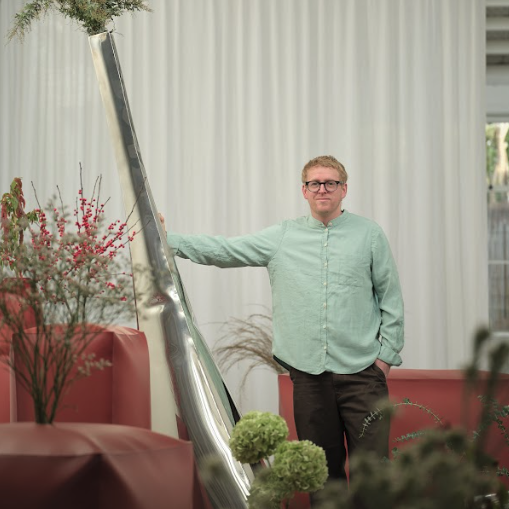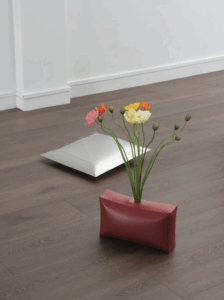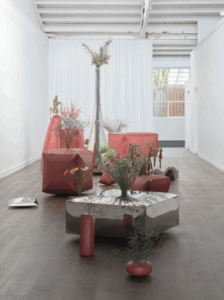We spoke with architect and artist Gerard Dombroski, about his current exhibition with Season. Read on to discover more about Gerard’s creative journey.
____________________
What first drew you to making art, and how has your practice evolved over time?
A lot of my childhood was spent making things in the woolshed, so I think I have an innate need to make things. I also have a lot of ideas that I want to see realised, and the easiest way to see them come to life has proven to be doing it myself.
I began more seriously making objects a few years into working at my first architecture job. While it started with a love of furniture, it quickly developed into more complex questions.. It went through a period where I saw my workshop as a design gym, a place where I could make and then question, I was attracted to the fast feedback loop and thought I could teach myself to be a better designer this way. Later I rationalised it as architecture research as I started to look for more conceptual ideas.
Furniture started to feel too “furniture-y,” and I found the questions I wanted to answer were moving into the realm of material experimentation and juxtapositions, e.g., hard things looking soft. Some of my favourite architecture seemed to be buildings whose structure was tied directly to its architecture, in this way they were very material driven and process based, but also buildings which offered an unexpecting experience or moment really caught my attention. So, in a rambling way to answer the question architecture led me to art but I did not know that at the time.
Now I am running an architecture practice upstairs and a predominantly sculptural practice downstairs. I can assure you it is not the simplest way to make a living but it is incredibly engaging artistically and allows me to propose ideas I might not otherwise consider.
You move between art, design, and architecture, how do those different approaches shape the way you think about and create sculpture?
Being an architect can be all encompassing and it really is a monocle through which you see the world so I can say with confidence that I view all my practice as architecture just at different scales. I think the different titles are helpful for people interacting with it but in my mind, I am just playing with a spectrum of domestic and structural elements all imagined to work as or with architecture. It may be a reference to architecture, for example a work I have at Season is called Chimney which is a reference to the wedge like chimneys on old DOC huts. Or it may be designed to work within architecture like a large vase that reads like a table.
As another thought the show, I was lucky enough to contribute to at Objectspace by Octavia Cook, we discussed architecture as an object that could perhaps be viewed as jewellery on the landscape. I think my introduction to the artistic world has allowed me to view things through an architectural lens but also to view architecture through a jeweller’s or potter’s lens as an example. I think this can become an incredible design tool.
While I drift away from time to time, I try to gear my making towards architectural experimentation and research. Structural systems, material experiments and most importantly touch, personal interaction and the idea of an object as a special tool. A large blue couch I made a few years ago I imagined almost as a landscape — something you could push together and inhabit like a pool.
Pictured: Gerard Dombroski, Inflation (Installation View), 2025. Courtesy of Season by Samuel Hartnett.
What inspired you to start using high-pressure water to inflate steel for these works at Season, and what do you enjoy about the process?
You may laugh but I enjoy a YouTube channel run by a British guy called Colin Furze. He is a very clever, mechanically minded person. He once made an object by welding two sheets of steel together and then inflating it with a water blaster. Around that time, I was making a café in Wellington in which I made steel curtains – sheets of metal flat along the top and pressed at the base so they draped like a curtain. These were then repeated along the wall of the café. This was an early experiment creating something visually soft out of a hard material and I thought to myself, watching this video, that I could make something very fabric looking, cushions. My mind was blown. This opened a whole new line of enquiry for me that I am still working through.
Something I love about the process is the giving up of control. I weld my shape together and then let the hydroforming do the rest, this is sometimes effortless, and other times incredibly frustrating as the shape may be too complex and the weld, at a certain point, is under too much stress – so it springs a leak before it has taken on a decent shape.
Pictured: Gerard Dombroski, Inflation (Installation View), 2025. Courtesy of Season by Samuel Hartnett.
Your sculptures often resemble playful, exaggerated versions of everyday objects. What draws you to making things that feel both familiar and strange?
I am very happy that is what comes across. I came across an artist called Porky Hefer during architecture school and he has been a good reminder for me to inject joy and the unexpected into my work. Combined with my architectural angle I often end up drawing on domestic elements. Imitation, I imagine also makes work relate to people, whether its nostalgia or someone sees the object within, the ease of understanding appeals to me. In the architecture world we can design from a conceptually dense place but sometimes we do not give people a bridge to know or even ask if there is more, they may just see a building. For example, I Made a café at the aquatic centre in Wellington where the café is entirely blue from floor to table height and white above. All the table tops are rounded wiggling shapes -‘ripples’. The café concept as you may have guessed, is a ‘swimming pool’ and I hope it is so obvious young children can engage with the whimsy and run around pretending they are swimming.
Looking ahead, where do you see your practice in 10 years, and what kinds of ideas or materials do you hope to explore?
I hope to have a practice where art and architecture weave together fluidly, in service of each other or imitating one another. I am deeply inspired by past architects who felt the need to design everything they could get their hands on, and hope to deepen my involvement in built projects. I think I am finally at a place where my office is equipped to bring that level of engagement and craft to any scale of a project – for example, knives and forks. I hope to meet a whole host of interesting people that want to go on exciting architectural and sculptural journeys in and beyond New Zealand.
My architecture practice currently has a community project where, to bring a depth of meaning to the very artistic community, I am proposing a living sculptural wall. A cladding that is designed to house and present a mass of curated community made sculptures and objects. I think this could bring both a unique architecture for the community and more individual meaning in a public building.
In the short term however, I am looking to upscale the hydroforming sculptural works into architecture. This will initially be through the construction of small-scale buildings such as sleepouts or back yard studios. This new scale of hydroforming is bound to bring a whole host of problems to solve, but that’s part of the fun. It also has the promise of an architecture I suspect has not been seen yet. I often wonder how far you could push this concept; I have been finding my self thinking of a long low mirrored rectangle house laying in the landscape, the reality of which is over 1million litres. This would comically need to be by a river or lake.
Fundamentally, I want to be creating architecture and objects that deliver the unexpected – in process and outcome – and that people feel they can interact with.


